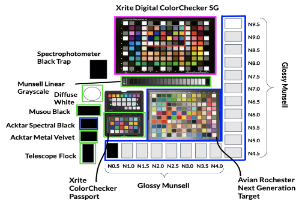
The capability for a camera to produce a color-accurate high dynamic range image is based upon its capture of luminance within a scene as well as the targets chosen to create the color transformation matrix. The wide-ranging luminance within a scene is an important part of cultural heritage documentation to appropriately capture an object's appearance. In addition, color accuracy is critical to documenting cultural heritage appropriately. This research compares prosumer and mobile phone cameras for cultural heritage documentation using single exposure and high dynamic range images. It focuses on the evaluation of color characterization process, color reproduction quality, and generation of the scene. This was done by using two types of prosumer cameras and two types of mobile phone cameras, at 800 lux with a wide range of color targets with various surface textures, matte, semigloss, and glossy. It was found that for creating color calibration matrices, a single exposure outperformed the one created from fusion of multiple exposure images. Additionally, including an extended achromatic scale along with the traditional Macbeth colors as part of the training data for the color calibration matrix may increase color accuracy for different cameras and the samples in the scene.

The color accuracy of an LED-based multispectral imaging strategy has been evaluated with respect to the number of spectral bands used to build a color profile and render the final image. Images were captured under select illumination conditions provided by 10-channel LED light sources. First, the imaging system was characterized in its full 10-band capacity, in which an image was captured under illumination by each of the 10 LEDs in turn, and the full set used to derive a system profile. Then, the system was characterized in increasingly reduced capacities, obtained by reducing the number of bands in two ways. In one approach, image bands were systematically removed from the full 10-band set. In the other, images were captured under illumination by groups of several of the LEDs at once. For both approaches, the system was characterized using different combinations of image bands until the optimal set, giving the highest color accuracy, was determined when a total of only 9, 8, 7, or 6 bands was used to derive the profile. The results indicate that color accuracy is nearly equivalent when rendering images based on the optimal combination of anywhere from 6 to 10 spectral bands, and is maintained at a higher level than that of conventional RGB imaging. This information is a first step toward informing the development of practical LED-based multispectral imaging strategies that make spectral image capture simpler and more efficient for heritage digitization workflows.

In this paper, we propose an automated adaptive focus pipeline for creating synthetic extended depth of field images using a reflectance transformation imaging (RTI) system. The pipeline proposed detects object regions at different depth levels relative to the camera’s depth of field and collects a most focused image for each. These images are then run through a focus stacking algorithm to create an image where the focus of each pixel has been maximized for the given camera parameters, lighting conditions, and glare. As RTI is used for many cultural heritage imaging projects, automating this process provides high quality data by removing the need for many separate images focused on different regions of interest on the object. It also lowers the skill floor for this image collection process by reducing the amount of manual adjustments that need to be made for focus. Furthermore, this can help to minimize the amount of time that a sensitive cultural heritage object is outside of its ideal preservation environment.